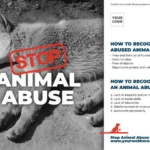Animal cruelty encompasses a broad spectrum of abusive behaviors inflicted upon non-human animals. It manifests in various forms, ranging from neglect and physical abuse to more insidious acts such as emotional torment and exploitation. Understanding the nuances of animal cruelty is paramount for students and activists alike, as it equips them to advocate effectively for animal welfare.
First and foremost, animal cruelty can be segmented into two primary categories: active cruelty and passive cruelty. Active cruelty involves deliberate actions taken to harm an animal. This includes acts such as physical beating, torture, or even killings. Passive cruelty, however, often stems from neglect. Animals can suffer greatly when basic needs such as food, water, shelter, and veterinary care are not provided. This form of cruelty may be unintentional, yet its effects are equally devastating.
Additionally, there are several specific types of animal cruelty that warrant attention. The most grievous form is undoubtedly the inhumane treatment of animals in industrial farming environments. Factory farming prioritizes profit over the welfare of animals, resulting in overcrowded living conditions, lack of adequate medical care, and cruel methods of slaughter. Animals raised in these conditions often experience immense physical and psychological suffering.
Another prevalent form is abuse in the context of entertainment. This includes cruel practices in circuses, dog fighting rings, and other forms of spectacle where animals are subjected to harsh training methods and abusive conditions. The objective of these exploitative practices is often to induce fear or submission, leaving lasting psychological scars on the animals involved.
In addition to overt cruelty, the concept of animal testing continues to pose ethical dilemmas. While scientific advancements have relied on animal testing, the ethical implications of causing sentient beings distress for the sake of human benefit raises considerable controversy. Although regulations have been put in place to minimize suffering, the debate remains vigorous over whether the ends truly justify the means.
Students should also familiarize themselves with the legal framework surrounding animal cruelty. Most countries have laws that aim to protect animals from suffering, yet enforcement varies widely. Understanding the specific statutes in one’s jurisdiction is crucial for effective advocacy. For example, in the United States, the Animal Welfare Act outlines protections for animals in research, exhibition, and transport, but its limitations in enforcing conditions in factory farming remain a contentious issue.
The psychological impact of witnessing or being aware of animal cruelty cannot be overlooked. Activists often experience what is known as “compassion fatigue,” a condition resulting from the prolonged exposure to the suffering of animals. Awareness of this phenomenon is critical for students and activists, as it underscores the importance of self-care while engaging in this emotionally charged pursuit. It is essential to find a balance between advocacy and personal well-being to sustain long-term involvement in animal rights.
Education is a powerful tool in combating animal cruelty. Informing peers, family members, and the community about the various forms of animal suffering can catalyze change. Schools can introduce curricula that address animal welfare and its importance, fostering empathy and responsibility in the next generation. Additionally, engaging in public discussions, writing articles, or creating social media campaigns can amplify awareness and encourage more individuals to join the cause.
As you begin to navigate the realm of animal rights activism, participating in local organizations is a valuable strategy. These groups often provide resources, training, and networking opportunities that can enhance your effectiveness as an advocate. Engaging with like-minded individuals fosters a sense of solidarity and can lead to collective efforts that amplify the message of compassion and change.
Fundamentally, it is essential for students and activists to be proactive in attending workshops, lectures, and community events centered around animal welfare. Knowledge is power, and understanding the complexities of animal cruelty can significantly heighten one’s ability to advocate effectively. Moreover, by attending these events, you can stay current on legislation, innovative animal protection strategies, and successful campaigns that have made a difference.
In summation, appreciating the depth of animal cruelty is vital for both students and activists. From recognizing the different categories and types of cruelty to understanding legal frameworks and the psychological ramifications of advocacy, a comprehensive approach is necessary. Collective knowledge and compassion can drive change, while individual actions can lead to profound transformations in the lives of countless animals. By fostering a culture of empathy and advocacy, we can strive to eradicate cruelty and establish a world where all living beings are treated with respect and dignity.





